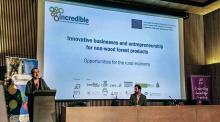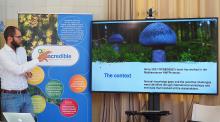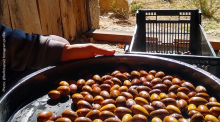Cooperative and labour diversification: elements for sustainable and quality forestry work

Sometimes, the profitability of the use of a forest resource depends more on the business model and entrepreneurial culture on which its exploitation is based, than on productivity factors or technological development associated with the use itself.
An innovative business success story linked to the activity of natural resin extraction, such as that of the company Pinaster Servicios Medioambientales, can serve as a reference for private entrepreneurs and public decision-makers to develop and support efficient business strategies that integrate the resin activity with other forest resources.
Natural resin extraction: an activity that needs to be rethought
In Europe, resins are generally self-employed workers who carry out the activity alone, whose main source of income, often the only one, is the selling of resin.
In the last ten years, rising resin prices have made the sector attractive enough for many young people without experience and workers from other sectors affected by the Spanish labour crisis that began in 2008, to embark on the adventure of becoming self-employed resin tappers.
Currently, the resin group is very vulnerable, with a high abandonment rate in the early years, sometimes with precarious income due to low production yields, which is defenceless against the volatility of international resin prices.
A good example of the vulnerability of this group to price reductions can be found in the crisis that broke out in the middle of the 2019 season when some Spanish resin tappers saw their sales prices reduced by around 30%.
It is well known that the international resin market goes through recurrent periods of sharp ups and downs, so a crisis of this kind was perfectly predictable, just as earthquakes are predictable in areas of seismic danger: in Los Angeles, there have been earthquakes and there will always be, only preventive measures can make the damage minimal and the angelina city will remain prosperous.
But taking preventive measures in the resin sector, especially to protect the weakest link in the value chain - the resin workers - is no easy task. There would be many elements that would have to be readapted to update the profession with 21st-century criteria.
In this sense, one of the ingredients that would contribute making the profession and the sector itself more sustainable and resilient would be the adoption of a cooperative labour model with a diversified offer of services, which integrates resin tapping with other complementary activities.
Resin extraction is compatible with rural tourism, mushroom and fruit picking, forestry work and, why not, with the prevention and monitoring of forest fires and pests
The Spanish cooperative Pinaster Servicios Medioambientales, based in Tabuyo del Monte, León, bases its business model on the extraction of natural resin complemented by other activities such as active rural tourism, micoturism, production of forest fruits, forestry work and timber harvesting.
Training is another key activity of the cooperative, both in terms of environmental education and resin techniques, within the framework of a business philosophy based on sustainability and a commitment to nature and ecology.
This model protects and strengthens resin workers and facilitates the survival of the business in adverse periods, typical of the fluctuating natural resin market.
Public administrations should promote excellent forestry work models, also recognizing the positive externalities that these workers generate
The traditional resin work, like that of other forest harvesters, is a livelihood that tends to be precarious and temporary and is threatened by major external factors arising from a globalized economy; threats too great to be faced alone by the workers themselves.
Public authorities should stimulate the generation of decent and quality rural employment through highly professionalised employment models, whose activity should be able to adapt efficiently to the business opportunities offered by multifunctional forest management. This initiative should avoid subsidies, but rather promote the creation of a network of cooperatives that provide a stable labour framework, an excellence employment niche.
For their part, the resin tappers should bet on forest cooperative movement, a formula that, also, generates benefits for the rural community as a socio-labour project for the future, contributing to the fight against depopulation in the resin producing regions.
Structuring the resin extraction sector through a network of resin cooperatives would also help to strengthen the resin sector itself as a whole, consolidating the weakest link in the value chain, a link that has proved to be strategic following the crisis in global supply chains generated by COVID19.
The implementation of this system is not easy. Many resin tappers are reluctant to adopt a cooperative working model based on production diversification. Besides, some of their main customers are comfortable with the current supply structure based on individual workers, who are easier to incorporate into the activity in the short term and have less negotiating power.
On the other hand, many public administrations do not recognize resin tappers as a quality labour resource for the maintenance and multifunctional use of forests.
To advance in this new productive model, programs for the expansion of cooperative activity among forest workers should be promoted, to overcome the current sectoral inertias regarding the resin worker model.
The training of the resin tapper must go beyond the traditional technical instruction scheme and go to a structure of tutoring and support to entrepreneurs and technical forestry workers, of quality and with the capacity to adapt to different tasks.
Public administrations should implement a territorial contract system based on multi-activity and forest maintenance that serves not only as a tool for remunerating resin workers for work and services but also as a new forest labour model adapted to the forest multifunctionality the positive externalities generation.















 Il progetto INCREDIBLE ("INNOVATION Networks of Cork, Resins and Edibles in the Mediterranean basin") riceve finanziamenti dal programma della Commissione Europea Horizon 2020 secondo il grant agreement Nº 774632.
Il progetto INCREDIBLE ("INNOVATION Networks of Cork, Resins and Edibles in the Mediterranean basin") riceve finanziamenti dal programma della Commissione Europea Horizon 2020 secondo il grant agreement Nº 774632.
Commenti (15203)
Incredible a good deal of very good data!
help with assignments my essay writer how to write a graduate admissions essay
ULTIMATE РТНС COLLECTION
NO PAY, PREMIUM or PAYLINK
DOWNLOAD ALL СР FOR FREE
Description:-> tiny.cc/zd48vx
Three girls and boy (Mpc37) Full
Girl 6yo and man, Sleep 9yo girl
----------
tiny.cc/sficzz
parg.co/Unyv
4ty.me/08yxs4
tt.vg/fiJTt
7z.si/r9z9
me2.kr/KBMgQ
j1d.ca/9j
gurl.pro/h3zljn
u2b.eu/zn
----------
000A000865
РТНС (>2Tb)
>>> tiny.cc/sficzz <<<
>>> parg.co/Unyv <<<
>>> 4ty.me/08yxs4 <<<
>>> tt.vg/fiJTt <<<
>>> 7z.si/r9z9 <<<
>>> me2.kr/KBMgQ <<<
>>> j1d.ca/9j <<<
>>> gurl.pro/h3zljn <<<
>>> u2b.eu/zn<<<
------
Pagine
Add Comment